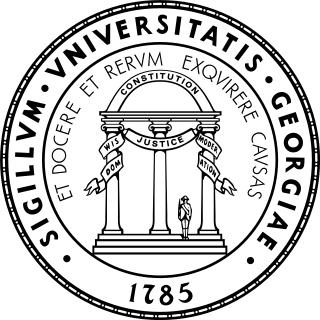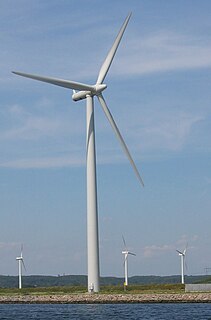
The University for Peace (UPEACE) is an intergovernmental organization with university status, established by treaty at the United Nations General Assembly in 1980 and having its main campus in Costa Rica. Its stated mission is "to provide humanity with an international institution of higher education for peace with the aim of promoting among all human beings the spirit of understanding, tolerance and peaceful coexistence, to stimulate cooperation among peoples and to help lessen obstacles and threats to world peace and progress, in keeping with the noble aspirations proclaimed in the Charter of the United Nations."

The conservation movement, also known as nature conservation, is a political, environmental, and social movement that seeks to protect natural resources including animal and plant species as well as their habitat for the future.

Chatham University is an American university that has coeducational academic programs through the doctoral level, with its primary campus located in the Shadyside neighborhood of Pittsburgh, Pennsylvania, United States. Chatham University maintains its Chatham Eastside location at the corner of Shadyside and the East Liberty neighborhood of Pittsburgh. This facility serves the health science and interior architecture programs. In 2013, Chatham opened its Eden Hall Campus, located in the Pittsburgh suburb of Richland Township, to house the Falk School of Sustainability & Environment. The current university student population of 2,110 includes 1,002 undergraduate students and 1,108 graduate students. The University grants certificates and degrees including bachelor, master, first-professional, and doctorate in the School of Arts, Science & Business, the School of Health Sciences, and the Falk School of Sustainability & Environment.

College of the Atlantic (COA) is a private, liberal-arts college in Bar Harbor on Mount Desert Island, Maine, United States. Founded in 1969, it awards bachelors and masters (M.Phil.) degrees solely in the field of human ecology, an interdisciplinary approach to learning. Focus areas include arts and design, environmental sciences, humanities, international studies, sustainable food systems, and socially responsible business.

José María Figueres Olsen is a Costa Rican businessman and politician. After he left the presidency of Costa Rica in 1998, Figueres has also been involved in global issues such as climate change, sustainable development, and technology. He started his career as an engineer working in agribusiness. After a decade, he entered public service as Minister of Foreign Trade and then Minister of Agriculture. In 1994, he was elected President of Costa Rica, as the nation's youngest elected president of the 20th century. In 2000, he joined the World Economic Forum in Switzerland, and later he worked with Concordia 21 in Madrid. Since 2010, he has been Chairman of the Carbon War Room, an independent non-profit organization focused on the global transition to a low-carbon economy. On 27 March 2012, Sir Richard Branson announced that he was appointed as the new President of the Carbon War Room.

California State Polytechnic University, Pomona is a public polytechnic university in Pomona, California. It is one of two polytechnics in the California State University system.

The State University of New York College of Environmental Science and Forestry is an American, specialized, doctoral-granting institution based in Syracuse, New York. It is immediately adjacent to Syracuse University, within which it was founded, and with whom it maintains a special relationship. ESF is a part of the State University of New York (SUNY) system. ESF also operates facilities in the Adirondack Park, the Thousand Islands, elsewhere in central New York, and Costa Rica. The College's curricula focus on the understanding, management and sustainability of the environment and natural resources. ESF is considered by Peterson's to be the premier college in the U.S. for the study of environmental and natural sciences, design, engineering, policy and management of natural resources and the environment. The college has expanded its initial emphasis on forestry to include professional education in environmental science, landscape architecture, environmental studies, and engineering in addition to distinguished programs in the biological and physical sciences. ESF is ranked at 43rd in the 2017 US News & World Report rankings of the top public national universities. It commemorated its centennial in 2011.

The University of Costa Rica is a public university in the Republic of Costa Rica, in Central America. Its main campus, Ciudad Universitaria Rodrigo Facio, is located in San Pedro Montes de Oca, in the province of San José. It is the oldest, largest, and most prestigious institution of higher learning in Costa Rica, originally established as the Universidad de Santo Tomás in 1843. It is also the most important research university in the country, and Central America. Approximately 45,000 students attend UCR throughout the year.

Augusta University is a public research university and academic medical center located in Augusta, Georgia, United States. It is a part of the University System of Georgia and has satellite medical campuses in Savannah, Albany, Rome, and Athens.
The University of Georgia Press or UGA Press is a scholarly publishing house for the University System of Georgia. It is the oldest and largest publishing house in Georgia and a member of the Association of American University Presses.
The Chicago Botanic Garden is a 385-acre (156 ha) living plant museum situated on nine islands in the Cook County Forest Preserves. It features 27 display gardens in four natural habitats: McDonald Woods, Dixon Prairie, Skokie River Corridor, and Lakes and Shores. The address for the garden is 1000 Lake Cook Road, Glencoe, Illinois. The garden is open every day of the year. Admission is free, but parking is $30 per car.
Frederick Corbet "Fred" Davison was the President of the University of Georgia (UGA) in Athens. He served in that capacity from 1967 until his resignation in 1986.

Ulmus mexicana(Liebm.) Planch., the Mexican elm, is a large tree endemic to Mexico and Central America. It is most commonly found in cloud forest and the higher elevations (800–2200 m) of tropical rain forest with precipitation levels of 2–4 m per year, ranging from San Luis Potosi south to Chiapas in Mexico, and from Guatemala to Panama beyond. The tree was first described botanically in 1873.
INCAE Business School is an international business school located at the Francisco de Sola campus in Nicaragua and the Walter Kissling Gam campus in Costa Rica. The Financial Times has ranked INCAE as a top global MBA program and The Wall Street Journal has ranked INCAE Business School as one of the top 10 international business schools in the world.

The Monteverde Cloud Forest Reserve is a Costa Rican reserve located along the Cordillera de Tilarán within the Puntarenas and Alajuela provinces. Named after the nearby town of Monteverde and founded in 1972, the Reserve consists of over 10,500 hectares of cloud forest, the reserve is visited by roughly 70,000 visitors a year. The Reserve consists of 6 ecological zones, 90% of which are virgin forest. An extremely high biodiversity, consisting of over 2,500 plant species, 100 species of mammals, 400 bird species, 120 reptilian and amphibian species, and thousands of insects, has drawn both scientists and tourists alike.
Costa Rican agriculture plays a profound part in that country’s gross domestic product (GDP). It makes up about 6.5% of Costa Rica’s GDP, and 14% of the labor force. Depending upon location and altitude, many regions differ in agricultural crops and techniques. The main exports include: bananas, pineapples, coffee, sugar, rice, vegetables, tropical fruits, ornamental plants, corn, potatoes and palm oil.

The Las Nubes Rainforest Preserve is a 145 hectare conservation reserve that is located an hour outside the city of San Isidro de El General, in San José Province, Costa Rica.
The University of Georgia's main campus sits across from the college town of Athens, Georgia, whose dominant architectural themes are Federal—the older buildings—and Classical and Antebellum style. The university is home to the University of Georgia Campus Arboretum.


















